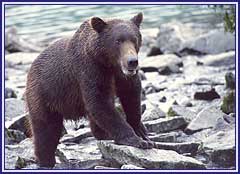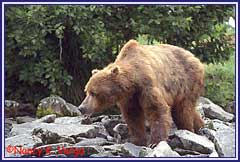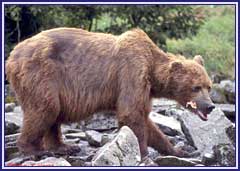|
Grizzly Attack - Timothy Treadwell
by Lynn Rogers
Everyone who follows bear news knows that Tim Treadwell and his
friend Amie Huguenard were killed by a grizzly bear in Katmai
National Park on October 5, 2003. The picture of the tragic scene in
Kaflia Bay is vivid in my mind because that is one of the places I
visited Tim during my trips to observe grizzlies.
The
last person to speak to Tim was his friend Jewel Palovak,
co-author of Tim’s book “Among Grizzlies.” He and Amie called her by
satellite phone on Sunday afternoon, October 5, to share the good
news that they had finally seen a favorite bear that Tim was worried
about and they could now come home.
|
Kaflia Bay

©Nancy K. Varga
|
Earlier, Tim had phoned his
pilot friend Willy Fulton to bring his float-plane to pick them up on
the beach on Monday. Sunday evening, Tim heard a bear outside the
tent and went out to see it. This was not unusual because the tent
was in a network of bear trails made by one of the densest
populations of grizzlies in the world. As he went out, he turned on
his sound recorder. For the next three minutes, Tim is heard
shouting that the bear is attacking him. Amie is telling him to play
dead and then to fight back. Tim, probably being held by the bear,
tells her to hit the bear. The sounds ended. The next day, Pilot
Willy Fulton arrived and flew over the camp and saw a flattened tent
and a large bear on a body. He buzzed the bear to scare it off, but
it stayed. Willy landed on the lake and called Alaska State Troopers
in Kodiak and National Park Rangers in King Salmon. The Rangers
arrived first and walked to the top of a knob that overlooks the
camp. An old male grizzly charged out of the bushes, and they killed
it. They estimated that it weighed over a thousand pounds despite
being underweight and having bad teeth. At the campsite, they found
the mostly eaten remains of Tim and Amie partially buried with torn
clothing scattered about. The tent was flattened but not torn. Any
food was secured in bear-proof containers. A bear wandered through
the campsite but paid scarce attention to the carcasses, the camp,
or the people. As the rangers were loading the camping equipment and
remains, a third bear approached persistently, and they killed it.
This one was a young male maybe three years old. They flew out. Two
days later, they returned to examine the stomach contents of the
dead bears. The larger bear contained human remains and clothing.
The smaller bear was eaten by other bears, and only its head
remained. There was nothing left to determine whether it had fed on
the victims.
|
Kaflia Bay

©Nancy K. Varga |
For
over twelve years, Tim had camped and lived among the bears of
Katmai National Park I had visited him at some of the locations he
wrote about in his book: The Meadow, The Forbidden Zone, and The
Maze (Kaflia Bay, where he was killed). He dressed consistently in
black, which probably helped the bears recognize him. They learned
that Tim was not a threat, and they accepted him as part of the
woodwork. He knew the bears individually. He knew their quirks and
moods and told me their names. Close interactions, even touching,
were commonplace for over twelve years between Tim and certain bears
with whom he shared a mutual trust. For the most part, the bears
calmly grazed, fished, clammed, and socialized with scant attention
to Tim. The bears probably assessed Tim’s demeanor constantly, just
as he assessed theirs, but Tim was trusting and nonthreatening, and
so were the bears. For example, I photographed a mother that calmly
stopped to play with her cub on the beach with Tim sitting less than
ten feet away. When she left, he told me her name and that he had
known her for years. The video camera that the Rangers found at
Tim’s campsite on October 6 contained recent footage of bears within
a few feet of Tim and Amie.
Tim was not without judgment or fear. Certain bears made him
wary. In his book, he named Demon as a bear that scared him at The
Maze (Kaflia Bay). He confided to me “A person could get killed out
here.” Scary moments were rare enough, though, that he saw no need
for an electric fence and he abandoned pepper spray. The bears were
basically timid, as I can attest. In my hundreds of hours of working
closely with these bears, I have never felt the slightest bit
threatened.
No one will ever know what possessed the bear to kill Tim and
Amie the evening of October 5. It is possible that it was a bear
that Tim had never met. Clint Hlebechuk, who also spends his summers
camping and hiking in Katmai National Park, told me that when he
gets far into the interior there are big old males that he never
sees on the beach. He said that silver salmon and pink salmon runs
were down this year, making it less likely that adequate numbers of
salmon were reaching the interior areas. This would draw out hungry
bears and increase competition at the mouths of the few streams that
have late salmon runs like the stream in Kaflia Bay.
|
Kaflia Bay

©Nancy K. Varga |
There
is no way to tell which of the bears that were killed at the
campsite killed Tim and Amie. A possible scenario is that the
smaller bear killed Tim and Amie and later lost their carcasses to
the bigger bear, as is common.
No one can explain what triggers predatory behavior in grizzlies.
One can only say that it is rare. About eighty percent of the
killings by grizzlies are by mothers defending their cubs. Another
ten percent or so are by grizzlies defending food caches. Only a
handful are predatory attacks.
Tim was a friend of the bears. His passion was to share his
observations that grizzlies are not the ferocious beasts we have
always thought them to be. He had a childlike quality that helped
him educate the thousands of children he visited in classrooms every
year. He also taught that people should not approach wild animals
and do what he does, and his website
goes on teaching that today. Another of Tim’s purposes was to deter
poachers who sometimes boat along the coast of Katmai National Park
after the tourists leave. The protected bears of Katmai are among
the largest grizzlies in the world. They live longer than bears in
hunting areas, and they grow to truly trophy size. Tim wanted to
stop poachers from shooting his friends and slipping away
undetected.
The last thing Tim and Amie would have wanted is to become
notorious for being the first fatalities in the history of the Park.
Tim once told our mutual friend, Kent Fredrikson, who similarly
spends his summers camping and walking among Katmai grizzlies, “If
they ever come to pick me up and find me dead, I hope they just bury
me and don’t say a word.” With all the publicity surrounding this
tragedy, I personally hope that people will not lose sight of the
rarity of this kind of event.
There is no way to tell which of the bears that were
killed at the campsite killed Tim and Amie. A possible scenario is
that the smaller bear killed Tim and Amie and later lost their
carcasses to the bigger bear, as is common.
No one can explain what triggers predatory behavior in
grizzlies. One can only say that it is rare. About eighty percent of
the killings by grizzlies are by mothers defending their cubs.
Another ten percent or so are by grizzlies defending food caches.
Only a handful are predatory attacks.
The Myth of
Timothy Treadwell |

